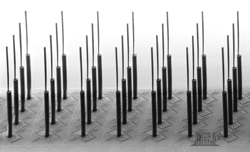Cricket inspired leap for bionic sensors
The cricket has tiny hairs which are so sensitive that they alert the insect to the possibility of imminent danger. Scientists at the university of Twente in the Netherlands, inspired by the crickets, have been able to create super-sensitive sensor technology capable of detecting acoustic signals at thermal noise levels. Based on drag-force mediated rotations of membranes, the scientists created a prototype sensor, achieving a feat in mechanical design. The project partners began by quantifying the chain of events in the cricket's response reaction. In particular they examined the way that crickets use hair-based sensors to measure small changes in air flow and detect approaching predators. In order to do this they mapped the motion of a single hair, as well as the array of hairs found on the cricket's cerci. The next phase of the project, taken up by the scientists at Twente University, was to fabricate the flow sensing electro-mechanical elements. They achieved this by means of silicon micro-machining technology. These sensors were integrated into arrays. An entire surface filled with these 'hairs' created the possibility of detecting patterns that come near to the 'sense of direction' the cricket has. This innovative sensor, inspired by nature, may be applied to solving hearing problems in humans. It is the ageing and deterioration of hair cells which cause bad hearing and these 'artificial hairs' may lead the way in designing replacement hair cells.

